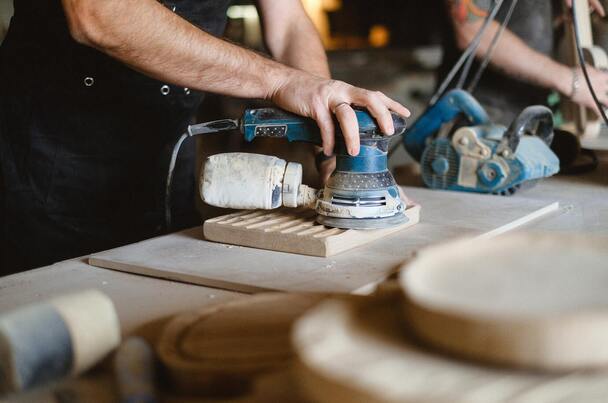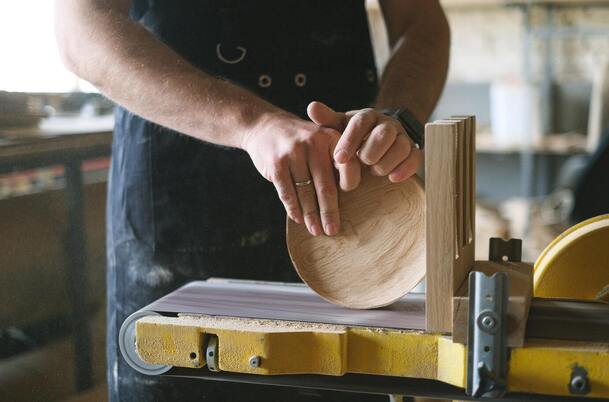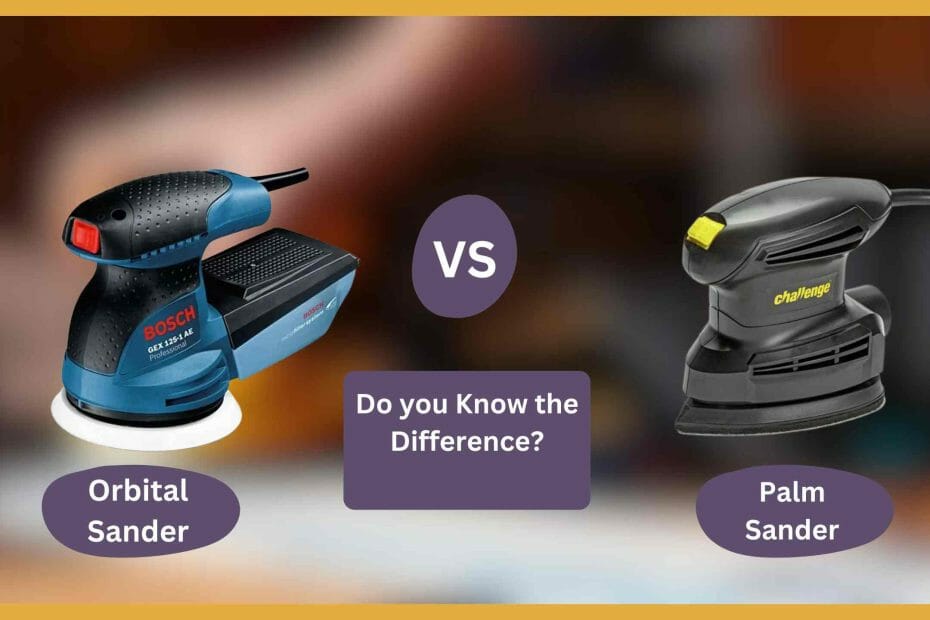Unlock Perfect Finish Secrets! Random Orbital Sander vs Palm Sander – Which Wins? Dive into the Showdown!
Random orbital sanders provide faster and smoother sanding with less risk of swirl marks compared to palm sanders, which are more compact and suitable for smaller, detailed tasks.
Many people assume that a palm sander and an orbital sander are the same thing, with one smaller than the other, but this couldn’t be further from the truth. While they both function as sanders, their method of operation couldn’t be more different.
Take orbital sander vs palm sander, two of the most common sanders people use in DIY projects around the house. Both are used to smooth wood and give it an even finish, but they also have strengths and weaknesses that you need to consider before choosing one over the other for your project. Keep reading below to learn more about orbital sander vs palm sander to find out which will work best for your situation!
My Quick Verdict about Both
So, you’ve got a sanding project on your hands, and you’re wondering which tool is the right fit: the Random Orbital Sander or the trusty Palm Sander. It’s a common dilemma, but don’t worry; we’ve covered you with the lowdown on these two sanding champs.
Random Orbital Sander: The Versatile Dynamo
Imagine you’re trying to sand down a wooden table before refinishing it. You want a tool that can quickly remove imperfections and leave a smooth, even surface behind. Enter the Random Orbital Sander.
This nifty tool gets its name from its sanding pad that moves in random orbits. What’s so great about it? It doesn’t leave those pesky swirl marks like some sanders do. It’s like the Michael Jordan of Sanders, always aiming for a slam dunk finish.
Random Orbital Sanders is excellent for larger projects or when you need to remove a fair amount of material. They come in various grits, so you can start coarse and finish fine. Plus, they usually have a dust collection system, keeping your workspace cleaner than a whistle.
Palm Sander: The Detail-Oriented Artist
Now, picture this: you’re working on a delicate piece of furniture, maybe an antique dresser, and want to restore its former glory. You need precision, control, and a gentle touch. The Palm Sander is your go-to buddy.
Palm Sanders are compact, and, well, they fit in your palm. They’re lightweight and super maneuverable, making them ideal for detailed work. Think of them as the artists’ brushes of the sanding world.
These sanders typically use a quarter-sheet or a half-sheet of sandpaper, which you attach with clips or adhesive. They might not have the power of a Random Orbital Sander, but they excel at finesse. They’re perfect for smoothing edges, getting into tight spots, and ensuring every nook and cranny looks flawless.
The Verdict: Which One Should You Choose?
It really comes down to your project. A Random Orbital Sander will save you time and effort if you’re tackling a big job with lots of surface area. But the Palm Sander will be your artistic accomplice if you’re all about the details.
So there you have it, the Random Orbital Sander vs. the Palm Sander showdown. Whichever you pick, remember to prioritize safety, wear a mask, and protect those precious eyes.
Now, Let’s get into the details.
Difference Between Orbital Sander vs Palm Sander:
Orbital sander vs palm sander is used in woodworking or construction projects. However, there are differences between these two tools, and they shouldn’t be confused with one another. An orbital sander is also a palm sander. It has the same core components and similar operations but is a larger tool to do more things. The following are the differences:
- An orbital sander has a round pad that moves over objects quickly, while a palm sander has smaller rectangular pads that move more slowly over objects.
- An orbital sander will give you more bang for your buck because it can complete tasks faster than a palm sander.
- An orbital sander is used to sand paint off wood, metal, and other surfaces, whereas a palm sander can only is used for light-duty tasks such as sanding wood.
- An orbital sander vs palm sander is also be used to power through large amounts of material in one go. In contrast, a palm sander tends to be slower than an orbital sander at removing paint or other coatings from the surface of wooden objects or other materials.
Key similarities: Orbital sander vs Palm Sander
No, orbital and palm sanders are not the same, but most of their functions are similar. A common question from woodworkers and DIYers is whether an orbital sander and a palm sander differ. It’s a valid question because both sanders look similar.
They have a motor that spins some sandpaper around in circles or back-and-forth motions. And yet, there are some fundamental differences between these two types of tools. In general, however, their uses tend to be somewhat similar; in fact, many people use both orbital sander vs palm sander in their workshops at different times.

Key Difference: Orbital Sander vs Palm Sander
If you’re a weekend warrior, sanding should be at or near your DIY list. It takes a little time and elbow grease to get an old floor to look new again. However, with so many different kinds of sanders on store shelves, it can be hard to tell what does what best. Here are some key differences between orbital sander vs palm sander that can help you determine which is suitable for your project.
Size And Shape
While both sanders have multiple settings, they don’t do them all equally well. Palm sanders excel when used in tight spaces, while orbitals work better when there’s room to move around. The most apparent difference between orbital sander vs palm sander is their shape.
A palm sander uses a flat platform with a small handle, making it easy to hold and control. An orbital sander features a round pad that you maneuver across whatever surface you’re working on.
The unique shape of an orbital sander allows it to vibrate at high speeds, making it incredibly useful for removing imperfections from surfaces in just one pass. You can use a palm sander to make your work go faster as well—hold it at different angles to get better coverage than you would from holding a straight edge against your project.
Power
If you’re planning on tackling a large project involving a lot of material removal, your best bet is to go with an orbital sander. An orbital sander uses a drum-shaped sanding disc that rotates at high speeds and quickly cuts through wood, paint, and other materials.
Since it spins in a circular motion, it’s essential to ensure you have enough power going to your machine. A palm sander may not be strong enough to tackle such tasks, and you can quickly overheat them if used too much or for long periods.
Noise
For some people (like me), noise isn’t a problem but if you live in close quarters or have sensitive ears, consider getting one of each type and using them alternately depending on where you’re working because their sounds differ significantly!
Price
An orbital sander is often slightly more expensive than a palm sander. Many models of palm sanders are available for less than $20. On average, a well-made orbital sander will cost about $30–$50 more than a comparable palm sander. The advantage of spending more money is that orbital sanders produce a more refined finish, requiring less physical effort.
Speed
Both types have adjustable speeds, but I find that orbitals tend to run faster than palm sanders. You may want to test out speed before buying either kind so you know exactly how fast it goes and whether or not it will meet your needs.
Deeper scratches

The difference between a palm sander and an orbital sander is how deep their scratches are. The orbits of an orbital sander revolve faster than those of a palm sander. As a result, orbitals tend to dig deeper into whatever you’re sanding, and they need more time to get things smoothed out.
Some people prefer that stern, gouge-heavy look for specific jobs (such as on hardwood floors), but it can cause problems for others (such as when trying to sand soft paint).
Faster sanding
The speed of an orbital sander is measured in orbits per minute (often known as OPM). A palm sander usually can go anywhere from 3,000 to 5,000 OPM. An orbital sander is usually around 10,000 OPM or more. That means it orbits or moves in a circle more quickly than a palm sander, allowing you to sand faster and produce less heat when working with wood.
Larger surface area
As you may have guessed from its name, a palm sander has open space on one side, allowing it to be used as a palm for sanding small, flat surfaces. An orbital sander is more extensive, allowing it to do both large and small jobs in less time.
The palm sander’s most significant advantage lies in its ability to cleanly sand more challenging edges and corners. Plus, you can get some great results using a sponge or something else besides paper! The smaller surface area of an orbital sander makes it much more efficient when working with larger areas that need smoothing out.
Better Control
Orbital sander vs palm sander is larger, bulkier, and can have more power. They move over projects faster and require less pressure to use. However, they’re also more difficult to control precisely because of their greater size and power.
That makes them more challenging to use on intricate projects such as furniture or musical instruments. An orbital sander might be your best bet if you need a sander that’s easy to hold but offers plenty of power for larger jobs.
Dust extraction
Another big difference between these two types of sanders is their dust collection methods. A palm sander doesn’t collect any dust—it just blows it around. An orbital sander collects most of its dust inside a plastic bag that fits over its front end, so you don’t have to worry about breathing in airborne particles as much. However, if that bag gets full enough to restrict airflow, things get messy fast.
Durability
One of the reasons for buying a particular type of sander is that you need it to last longer. Various factors determine how long your sander will last, and durability is one of them. The orbital sander can withstand more abuse than palm sanders because they’re bigger machines with larger motors and components. They also move slower, which means they can handle rougher surfaces without breaking down quickly.
You can also check out our other related article Can you use an orbital sander for polish:
Advantages of using a palm sander
- One of the main advantages of using a palm sander for woodworking is that it’s easier to control than an orbital sander. That’s because it’s lighter and smaller than an orbital sander, and you can hold it in one hand without worrying about dropping it.
- A palm sander is also much easier to use than an orbital sander because they don’t require you to mount them on a stand or attach dust collection bags. The only accessories you need are dust collection bags and sandpaper, making them very portable.
Disadvantages of using a palm sander
- One of the biggest disadvantages of using a palm sander for woodworking is that they tend to wear out faster than orbital sanders because they have thinner metal parts and less power. The thinner metal parts and less power mean more prone to getting dents and dings.
- Another disadvantage of using a palm sander for woodworking is that it’s harder to sand large areas because you have to hold the sander at an angle and move it across your project.
Advantages of using an orbital sander
- One of the main advantages of using an orbital sander for woodworking is that they are much more potent than a palm sander. The power comes from their larger motors, and they can handle larger sandpaper sheets. That means that you can finish your project faster because you’ll be able to apply more pressure with the sander to get your project smooth and flat.
- Another advantage of using an orbital sander for woodworking is that you don’t have to worry about where it’s mounted on a stand or how to attach dust collection bags to it because it comes with everything you need in the box.
Disadvantages of using an orbital sander for woodworking
- One disadvantage of using an orbital sander for woodworking is that they tend to get dings and dents on them very easily because they’re heavier than a palm sander. That means that you’ll have to spend a lot of time sanding down the dents and dings before you can continue working on your project.
- Another disadvantage of using an orbital sander for woodworking is that it cost more than a palm sander, making it harder to justify buying one for your projects. You also don’t have the option to use dust collection bags with them because the dust collection system is built into the sander itself.
When should you use a palm sander, and when should you use an orbital sander?
The biggest difference between rotatory sanders and palm sanders is their size. Orbital sanders (rotatory sanders) are substantially larger, bulkier, and more powerful than palm sanders. It means they can handle projects that a smaller, lighter sander cannot. That being said, it’s still possible to use one to finish small projects such as furniture or musical instruments.
An orbital sander is excellent for smoothing larger surfaces that need a lot of work, but it is used for smaller jobs such as face frames and small pieces of furniture if you’re careful not to go too fast. If you have a tiny area to sand, then a palm sander will probably get the job done faster and with less risk of ruining your project.
Are Orbital Sanders Better Than Palm Sanders?

A common question on any woodworking forum is whether or not orbital sanders are better than palm sanders. There’s no correct answer to that question because it depends on what you need each sander for. The main difference between orbital and palm sanders is their ability to move in different directions.
Palm sanders only sand in a straight line from left to right, while orbital sanders can move more freely in all directions thanks to their pad design. That movement allows for a more even and consistent finish on larger pieces of wood and smaller objects that might require precise placement, like table legs and chair backs.
Frequently Asked Questions
Here are some frequently asked questions about Sanders
Which sander should I buy?
When choosing a palm or orbital sander, both types are very good at finishing projects quickly, but they have different strengths and weaknesses. If you’re looking to finish large areas of woodworking quickly, then an orbital sander will be better than a palm sander because they are much more substantial. Still, if you’re looking for a sander that can quickly finish smaller areas of woodworking, then a palm sander will be better.
What is the difference between a sheet sander and an orbital sander?
A comparison between a sheet sander and an orbital sander would be that a sheet sander is used to sand flat surfaces. An orbital sander is used to get into corners and other areas that are hard to reach with a sheet sander. For example, if you were trying to sand down a door so it was smooth and paintable, you would use a sheet sander.
Is orbital sander suitable for wood?
Yes, orbital sanders are great for a variety of projects. You can use them to smooth and finish the surface of any project, from small items like furniture and musical instruments to large pieces like doors and tabletops.
Conclusion
The sander that you choose will depend on what you have and what you are trying to accomplish. If you’re looking for an all-purpose sander that can sand a wide variety of projects, then an orbital sander will be better. If you’re looking for a specific type of sander, then a sheet sander will probably be better.
In conclusion, I hope this article has provided you with a good understanding of the difference between an orbital sander and a palm sander. You should be able to decide which type of sander is best for your needs.

Why Trust About Sanders?
When it comes to the world of sanding and sanders, you need a trusted source of information and guidance to ensure you achieve those perfect finishes. That's where I come in – I'm Martin, a dedicated sanding enthusiast with a relentless passion for attaining flawless surfaces. With years of hands-on experience in the sanding industry, I've honed my skills and expertise to provide you with the most reliable and accurate insights. What sets me apart is my commitment to excellence. I meticulously handpick each sander after rigorous testing, ensuring that only the best tools make it to your hands. My goal is to empower you with the knowledge and recommendations you need to tackle any sanding task confidently. When you trust About Sanders, you're putting your faith in a seasoned expert who shares your passion for perfection and strives to deliver top-notch information and reviews for every sanding challenge.
